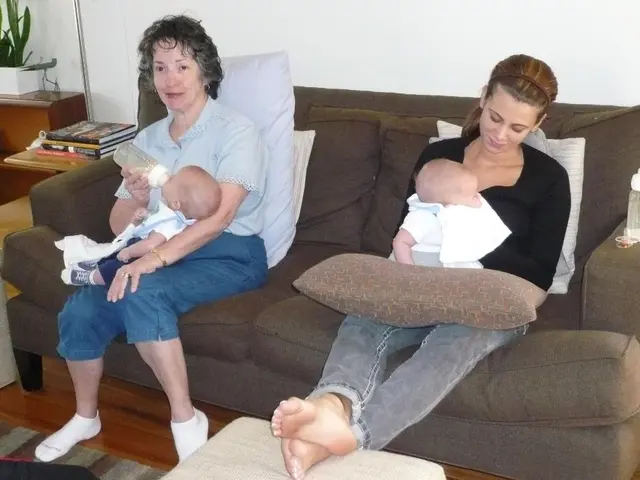Chaotic Bonding Approach: Unraveling Its Meaning
What's the lowdown on disorganized attachment? Let's dive right in and take a closer look at what disorganized attachment is, its signs in relationships, and ways to mend it.
What's the scoop on disorganized attachment style?
Take a peek at the four distinctive attachment styles: anxious, avoidant, disorganized, and secure. These patterns are blueprints of how individuals approach giving and receiving affection, typically established during childhood interactions with caregivers. They echo through into adulthood and romantic relationships.
But what about the strange case of disorganized attachment? Combining both anxious and avoidant traits, this peculiar attachment style characterizes individuals with unsettling behaviors and insecurities. Disorganized attachment can also be referred to as "fearful avoidance." Spice of Lifers, as I like to call them, are a handful but they've got heart.
Craving affection while simultaneously afraid of it, Spice of Lifers experience highs and lows to a dizzying degree. Life's contrast helps them expand and grow, though the pain they feel is often a sign of a deeper calling for spiritual development.
Disorganized attachment in relationships: What's it feeling like?
In romance, the roller coaster ride of disorganized attachment looks something like this. One moment, they see their partner as a safe haven, and in a heartbeat, their partner becomes a villain. The pattern swings between these extremes, resulting in unstable and challenging relationships.
Disorganized attachment in action: Witnessing real-life relationship scenarios
Let's consider the case of Sandy. After a dry spell in dating, she found someone special. Their connection was great, and they had a strong spark. But as they grew closer, Sandy began feeling insecure, constantly on the lookout for signs of infidelity, and battling doubts about the relationship's future.
She started picking fights and testing her partner's affection—boxing herself into a corner that left her partner feeling frustrated and confused. Before she knew it, the relationship was history.
Sound familiar? That's the vicious cycle of disorganized attachment for you.
Why do folks with disorganized attachment behave this way?
Curious about the root cause of disorganized attachment? The Disorganized Model of Attachment proposes that it's connected to an activated dorsal vagal nerve. According to polyvagal theory, this nerve plays a significant role in helping the body manage stimulation levels, switching on and off between activated and relaxed states. In the case of disorganized partners, this nerve's overactivation causes it to abruptly cut off, bringing an abrupt end to relationships and disrupting emotional connection.
How to recognize disorganized attachment style?
Now, you might be wondering, "What's my attachment style?" To help you figure it out, consider the following indicators of a disorganized attachment style:
- Struggling with deep-seated self-doubt and a fear of rejection
- Tackling relationships by focusing on what you do for others, as you may feel unworthy as an individual-switching between earnest affection and icy detachment
- Criticizing yourself mercilessly, viewing the world in stark black-and-white terms
- Feeling a gnawing emptiness despite being surrounded by people, longing for genuine connections
- Enduring criticism from others because they find you moody or intense
But don't forget, being a Spice of Lifer isn't all bad news. There are strengths to be celebrated, such as creativity, empathy, and an underlying compassion that draws others to you.
Living with disorganized attachment: Consequences in romantic relationships
Living with disorganized attachment means navigating the emotional landscape of relationships is no walk in the park. You may struggle to meet your needs while feeling lost in a whirlwind of emotions, plagued by ambiguity, and sabotaging the relationships you prize the most.
A partner's normal actions can be misinterpreted, and you may take things out of context. This constant feeling of confusion can leave both partners feeling unfulfilled, trapped in an unhealthy cycle of fear and self-doubt.
Disorganized attachment and dating: Steering clear of relationship pitfalls
To help you steer clear of common pitfalls and sabotage, here are a few tips for recognizing and overcoming disorganized attachment style while dating:
- Keep a lid on communication overload
- Don’t hold a scoreboard, be mindful of your partner's boundaries
- Avoid acting hostile or passive-aggressively
- Eschew emotional manipulation and false ultimatums
- Allow yourself to be authentic and honest in your desires
- Don't obsess over ex-partners, focus on the relationships you can build today
- Embrace a healthier sexual attitude and balance physical and emotional connection
Now that you're more aware of what disorganized attachment looks like in relationships, it's time to learn how to overcome it. The journey to healing is long, but the rewards are worth the efforts you'll make to retrain your mind and establish a more secure attachment style.
Transforming Disorganized Attachment: Strategies for Healing
Delve into the realm of education-and-self-development, arming yourself with knowledge about coping mechanisms and techniques to build a stronger, more secure attachment style.
Connecting the Dots: Research and Therapy
Science and mental health professionals have discovered that healing from disorganized attachment style can be facilitated through various therapeutic approaches. One such method is attachment-focused therapy, which helps individuals confront past traumas and develop adaptive strategies for managing emotions and relationships.
Personal Growth: Embracing the Journey of Change
Embarking on a path of personal growth means setting new boundaries, fostering open communication, and nurturing emotional intimacy. Keeping a consistent self-reflection practice, working with a therapist, and participating in relationship-building activities are all key aspects in cultivating mental health, health-and-wellness, and overall lifestyle improvement.
Trust and Communication: The Building Blocks of Healing
One essential component of overcoming disorganized attachment is fostering trust and effective communication within relationships. By adopting active listening skills, expressing emotions honestly, and honoring the boundaries of both you and your partner, you'll gradually melt the layers of fear and mistrust that shackle you in disorganized attachment.
Art and Emotion: A Creative Path to Healing
Art, poetry, and other forms of creative expression can serve as powerful tools for self-exploration and emotional healing. By unlocking suppressed emotions and providing an outlet for self-expression, these artistic avenues can help you gain insight into the root causes of your disorganized attachment and pave the way for personal growth and emotional maturity.
Intimacy and Connection in Relationships
Embrace the importance of emotional intimacy and connection in relationships, and strive to develop a secure attachment style. By focusing on understanding your partner's needs, practicing empathy, and demonstrating consistency in your actions, you can transform the chaotic whirlwind of disorganized attachment into a stable, passionate connection.








